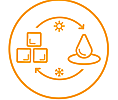
Document IIF
Analyse thermique expérimentale d’un puits de chaleur innovant couplé à une nanoémulsion.
Experimental thermal analysis of an innovative heat sink coupled to a nanoemulsion.
Numéro : 0030
Auteurs : RIGHETTI G., BURGOS J., HERNANDEZ L., MONDRAGON R., BARISON S., AGRESTI F., BIASETTO L., MANCIN S.
Résumé
This work presents some new experimental measurements collected on a very innovative system proposed for electronic cooling. This setup combines a classical heat sink with a latent thermal storage. The storage material used is a phase change nanoemulsion made of water and 5 wt. % RT40HC paraffin wax with 1-octadecanol as nucleating agent (weight fraction 1:10 with respect to PCM) to reduce the supercooling up to 38 % with respect to samples without nucleating agent, while the heat sink is made of copper via 3D printing. The integration between the two components does not interfere with the external air convective heat transfer, as the nanoemulsion is embedded inside the heat sink, which has an internal cavity. The tests analyse the temperature of the component and the nanoemulsion in different locations during the charging and discharging phases at several flow rates. The results compare the behaviour of this innovative system to a system with the same geometry and only water inside. The presence of the latent thermal storage slightly modifies the temperature field.
Documents disponibles
Format PDF
Pages : 6 p.
Disponible
Prix public
20 €
Prix membre*
Gratuit
* meilleur tarif applicable selon le type d'adhésion (voir le détail des avantages des adhésions individuelles et collectives)
Détails
- Titre original : Experimental thermal analysis of an innovative heat sink coupled to a nanoemulsion.
- Identifiant de la fiche : 30032383
- Langues : Anglais
- Sujet : Technologie
- Source : 14th IIR Conference on Phase-Change Materials and Slurries for Refrigeration and Air Conditioning. Proceedings: Paris France, May 29-31, 2024.
- Date d'édition : 31/05/2024
- DOI : http://dx.doi.org/10.18462/iir.pcm.2024.0030
Liens
Voir d'autres communications du même compte rendu (40)
Voir le compte rendu de la conférence
Indexation
-
Experimental comparison of different composite ...
- Auteurs : VEELKEN H., SCHMITZ G.
- Date : 11/07/2016
- Langues : Anglais
- Source : 2016 Purdue Conferences. 16th International Refrigeration and Air-Conditioning Conference at Purdue.
- Formats : PDF
Voir la fiche
-
Combined study of a D-mannitol based energy sto...
- Auteurs : VIALETTES L., FATAHI H., PONCET S.
- Date : 01/09/2021
- Langues : Anglais
- Source : 13rd IIR Conference on Phase-Change Materials and Slurries for Refrigeration and Air Conditioning. Proceedings: (online) Vicenza, Italy, September 1-3, 2021.
- Formats : PDF
Voir la fiche
-
Effect of metal foam integration on the thermal...
- Auteurs : KOTB A., WANG S.
- Date : 2022
- Langues : Anglais
- Source : 2022 Purdue Conferences. 19th International Refrigeration and Air-Conditioning Conference at Purdue.
- Formats : PDF
Voir la fiche
-
TESSe2b - Thermal energy storage systems for en...
- Auteurs : GARCÍA J., COELHO L., REBOLA A.
- Date : 19/06/2018
- Langues : Anglais
- Source : CYTEF 2018. IX Congreso Ibérico y VII Congreso Iberoamericano de Ciencias y Técnicas del Frío, Valencia, España, 19-21 junio 2018.
- Formats : PDF
Voir la fiche
-
Experimental study on the role of metal foams i...
- Auteurs : RIGHETTI G., MANCIN S., ZILIO C., LONGO G. A.
- Date : 01/09/2021
- Langues : Anglais
- Source : 13rd IIR Conference on Phase-Change Materials and Slurries for Refrigeration and Air Conditioning. Proceedings: (online) Vicenza, Italy, September 1-3, 2021.
- Formats : PDF
Voir la fiche
